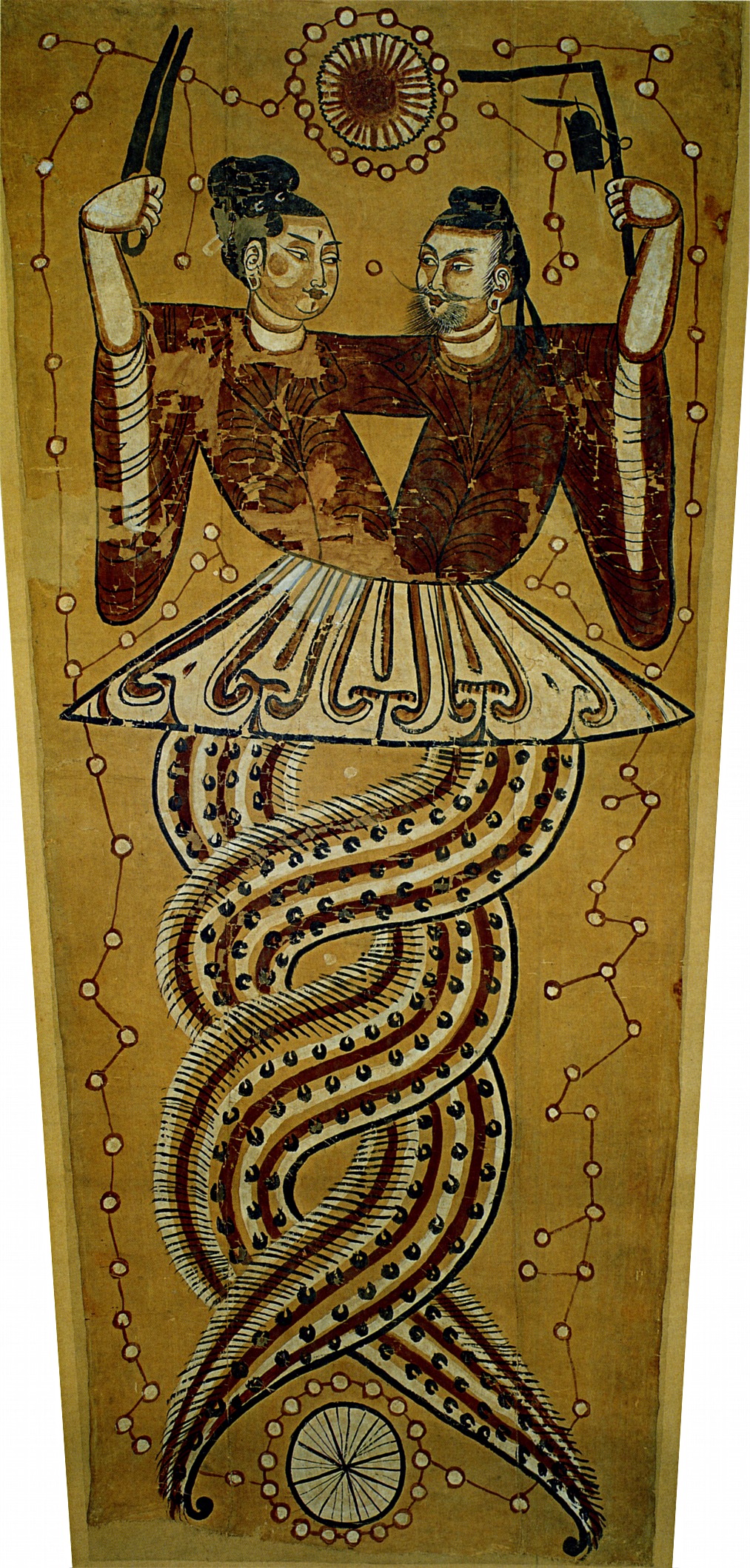|
Snakes In Chinese Mythology
Snakes (also known as serpents) are an important motif in Chinese mythology. There are various myths, legends, and folk tales about snakes. Chinese mythology refers to these and other myths found in the historical geographic area(s) of China. These myths include Chinese and other languages, as transmitted by Han Chinese as well as other ethnic groups (of which fifty-six are officially recognized by the current administration of China). Snakes often appear in myth, religion, legend, or tales as fantastic beings unlike any possible real snake, often having a mix of snake with other body parts, such as having a human head, or magical abilities, such as shape-shifting. One famous snake that was able to transform back and forth between a snake and a human being was Madam White Snake in the Legend of the White Snake. Other snakes or snake-like beings sometimes include deities, such as Fuxi and Nüwa and Gong Gong. Sometimes, Fuxi and Nuwa are described as snakes with human heads and som ... [...More Info...] [...Related Items...] OR: [Wikipedia] [Google] [Baidu] |
Snake (zodiac)
The snake ( 蛇) is the sixth of the twelve-year cycle of animals which appear in the Chinese zodiac related to the Chinese calendar. The Year of the Snake is associated with the Earthly Branch symbol 巳. According to one legend, there is a reason for the order of the animals in the cycle. The story goes that a race was held to cross a great river, and the order of the animals in the cycle was based upon their order in finishing the race. In this story, the snake compensated for not being the best swimmer by hitching a hidden ride on the Horse's hoof, and when the horse was just about to cross the finish line, jumping out, scaring the horse, and thus edging it out for sixth place. The same twelve animals are also used to symbolize the cycle of hours in the day, each being associated with a two-hour time period. The hour of the snake is 9:00 to 11:00 a.m., the time when the Sun warms up the Earth, and snakes are said to slither out of their holes. The month of the sn ... [...More Info...] [...Related Items...] OR: [Wikipedia] [Google] [Baidu] |
Mount Heng (Shanxi)
Mount Heng, also known by its Chinese name Hengshan, is a mountain in north-central China's Shanxi Province, known as the northern mountain of the Five Great Mountains of China. Heng Shan in Shanxi Province is sometimes known as the Northern Heng Shan, and the one in Hunan Province as Southern Heng Shan. Both mountains have the same pronunciation in Chinese, and the Southern Heng Shan is also one of the Five Sacred Mountains. History Like the other mountains in China with strong Taoist presence, Heng Shan has been considered a sacred mountain since the Zhou Dynasty. Due to its northerly location, often under control of non-Chinese nations, the mountain has a weaker history of pilgrimage than its four fellows. Indeed, to this day it is the least-visited and least-developed of the five, also the smallest in area. Because of this, Hengshan is not nearly as religiously important in China as the other Taoist mountains.Goosseart (2008), p. 481. But as a further consequence, it is ... [...More Info...] [...Related Items...] OR: [Wikipedia] [Google] [Baidu] |
Roger T
Roger is a given name, usually masculine, and a surname. The given name is derived from the Old French personal names ' and '. These names are of Germanic origin, derived from the elements ', ''χrōþi'' ("fame", "renown", "honour") and ', ' ("spear", "lance") (Hrōþigēraz). The name was introduced into England by the Normans. In Normandy, the Frankish name had been reinforced by the Old Norse cognate '. The name introduced into England replaced the Old English cognate '. ''Roger'' became a very common given name during the Middle Ages. A variant form of the given name ''Roger'' that is closer to the name's origin is '' Rodger''. Slang and other uses Roger is also a short version of the term "Jolly Roger", which refers to a black flag with a white skull and crossbones, formerly used by sea pirates since as early as 1723. From up to , Roger was slang for the word "penis". In ''Under Milk Wood'', Dylan Thomas writes "jolly, rodgered" suggesting both the sexual double e ... [...More Info...] [...Related Items...] OR: [Wikipedia] [Google] [Baidu] |
Sunzi Bingfa
''The Art of War'' () is an ancient Chinese military treatise dating from the Late Spring and Autumn Period (roughly 5th century BC). The work, which is attributed to the ancient Chinese military strategist Sun Tzu ("Master Sun"), is composed of 13 chapters. Each one is devoted to a different set of skills or art related to warfare and how it applies to military strategy and tactics. For almost 1,500 years it was the lead text in an anthology that was formalized as the Seven Military Classics by Emperor Shenzong of Song in 1080. ''The Art of War'' remains the most influential strategy text in East Asian warfare and has influenced both Far Eastern and Western military thinking, business tactics, legal strategy, politics, sports, lifestyles and beyond. The book contains a detailed explanation and analysis of the 5th-century BC Chinese military, from weapons, environmental conditions, and strategy to rank and discipline. Sun also stressed the importance of intelligence opera ... [...More Info...] [...Related Items...] OR: [Wikipedia] [Google] [Baidu] |
Sunzi
Sun Tzu ( ; zh, t=孫子, s=孙子, first= t, p=Sūnzǐ) was a Chinese military general, strategist, philosopher, and writer who lived during the Eastern Zhou period of 771 to 256 BCE. Sun Tzu is traditionally credited as the author of ''The Art of War'', an influential work of military strategy that has affected both Western and East Asian philosophy and military thinking. Sun Tzu is revered in Chinese and East Asian culture as a legendary historical and military figure. His birth name was Sun Wu ( zh, t=孫武, s=孙武, first=t) and he was known outside of his family by his courtesy name Changqing ( zh, t=長卿). The name ''Sun Tzu'' by which he is more popularly known is an honorific which means "Master Sun". Sun Tzu's historicity is uncertain. The Han dynasty historian Sima Qian and other traditional Chinese historians placed him as a minister to King Helü of Wu and dated his lifetime to 544–496 BCE. Modern scholars accepting his historicity place the extant tex ... [...More Info...] [...Related Items...] OR: [Wikipedia] [Google] [Baidu] |
Cryptozoology
Cryptozoology is a pseudoscience and subculture that searches for and studies unknown, legendary, or extinct animals whose present existence is disputed or unsubstantiated, particularly those popular in folklore, such as Bigfoot, the Loch Ness Monster, Yeti, the chupacabra, the Jersey Devil, or the Mokele-mbembe. Cryptozoologists refer to these entities as '' cryptids'', a term coined by the subculture. Because it does not follow the scientific method, cryptozoology is considered a pseudoscience by mainstream science: it is neither a branch of zoology nor of folklore studies. It was originally founded in the 1950s by zoologists Bernard Heuvelmans and Ivan T. Sanderson. Scholars have noted that the subculture rejected mainstream approaches from an early date, and that adherents often express hostility to mainstream science. Scholars have studied cryptozoologists and their influence (including the pseudoscience's association with Young Earth creationism), noted parallel ... [...More Info...] [...Related Items...] OR: [Wikipedia] [Google] [Baidu] |
Duanwu
The Dragon Boat Festival ( zh, s=端午节, t=端午節) is a traditional Chinese holiday which occurs on the fifth day of the fifth month of the Chinese calendar, which corresponds to late May or June in the Gregorian calendar. Names The English language name for the holiday is Dragon Boat Festival, used as the official English translation of the holiday by the People's Republic of China. It is also referred to in some English sources as Double Fifth Festival which alludes to the date as in the original Chinese name. Chinese names by region ''Duanwu'' (), as the festival is called in Mandarin Chinese, literally means "starting/opening horse", i.e., the first "horse day" (according to the Chinese zodiac/ Chinese calendar system) to occur on the month; however, despite the literal meaning being '' wǔ'', "the ay of thehorse in the animal cycle", this character has also been interchangeably construed as ''wǔ'' () meaning "five". Hence ''Duanwu'', the "festival on the fifth da ... [...More Info...] [...Related Items...] OR: [Wikipedia] [Google] [Baidu] |
Chinese Calendar
The traditional Chinese calendar (also known as the Agricultural Calendar ��曆; 农历; ''Nónglì''; 'farming calendar' Former Calendar ��曆; 旧历; ''Jiùlì'' Traditional Calendar ��曆; 老历; ''Lǎolì'', is a lunisolar calendar which identifies years, months, and days according to astronomical phenomena. In China, it is defined by the Chinese national standard GB/T 33661–2017, "Calculation and Promulgation of the Chinese Calendar", issued by the Standardization Administration of China on May 12, 2017. Although modern-day China uses the Gregorian calendar, the traditional Chinese calendar governs holidays, such as the Chinese New Year and Lantern Festival, in both China and overseas Chinese communities. It also provides the traditional Chinese nomenclature of dates within a year which people use to select auspicious days for weddings, funerals, moving or starting a business. The evening state-run news program '' Xinwen Lianbo'' in the P.R.C. continues to anno ... [...More Info...] [...Related Items...] OR: [Wikipedia] [Google] [Baidu] |
Earthly Branches
The twelve Earthly Branches or Terrestrial Branches are a Chinese ordering system used throughout East Asia in various contexts, including its ancient dating system, astrological traditions, zodiac and ordinals. Origin This system was built from observations of the orbit of Jupiter. Chinese astronomers divided the celestial circle into 12 sections to follow the orbit of ''Suìxīng'' (Jupiter, the Year Star). Astronomers rounded the orbit of Suixing to 12 years (from 11.86). Suixing was associated with ''Shètí'' ( η Boötis) and sometimes called Sheti. Jonathan Smith has proposed that the first meanings of the earthly branches, predating the Shang dynasty, were phases of the moon, with the heavenly stems at that point referring to divisions of the ecliptic. After being adopted as a calendar these would have lost their clear lunar reference, permitting their repurposing for Jupiter stations. History In correlative thinking, the 12 years of the Jupiter cycle also ... [...More Info...] [...Related Items...] OR: [Wikipedia] [Google] [Baidu] |
Horse (zodiac)
The Horse ( ⾺) is the seventh of the 12-year cycle of animals which appear in the Chinese zodiac related to the Chinese calendar. There is a long tradition of the Horse in Chinese mythology. Certain characteristics of the Horse nature are supposed to be typical of or to be associated with either a year of the Horse and its events, or in regard to the personality of someone born in such a year. Horse aspects can also enter by other chronomantic factors or measures, such as hourly. The year of the horse is associated with the Earthly Branch symbol 午. History The lunar calendar paved the sequence of the Chinese zodiac animals. This calendar can be traced back to the 14th century B.C. Myths say that Emperor Huangdi, the first Chinese emperor, in 2637 B.C. invented the Chinese lunar calendar, which follows the cycles of the moon. In a folklore story that explains the origins of the cycle, the animals hold a race to determine their order. The custom of pairing an animal ... [...More Info...] [...Related Items...] OR: [Wikipedia] [Google] [Baidu] |






